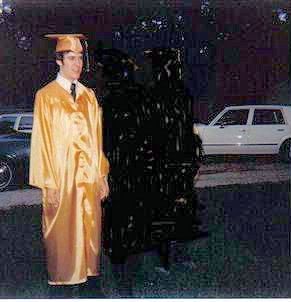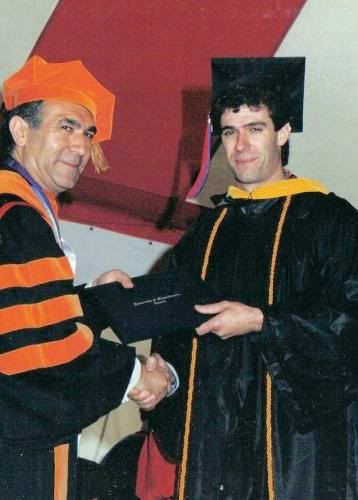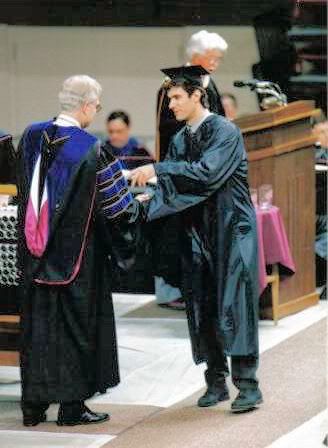Ernest Richard Toracinta

Rick High School Senior
Education:
December 2000 Ph.D., Atmospheric Sciences, Department of Atmospheric Sciences, Texas A&M University, College Station, Texas. Advisor: Dr. Edward Zipser
Dissertation title: "Mesoscale Convective Systems in the Global Tropics: Relationships Between Lightning and Microwave Ice-Scattering Signatures"
1993 - 1995 M.S., Meteorology, Texas A&M University, College Station, Texas
Thesis title: "Radar, Satellite, and Lightning Characteristics of Select Mesoscale Convective Systems in Texas" 1989 - 1993 B.S., Meteorology (Magna Cum Laude), Department of Environmental, Earth, and Atmospheric Sciences, University of Massachusetts, Lowell, Massachusetts. Research Experience:
December 2000 - present Polar Meteorology Group, Byrd Polar Research Center, The Ohio State University Currently working on global and regional modelling of the Last Glacial Maximum climate. Particular emphasis is on high-resolution simulations of the atmospheric state over the Laurentide Ice Sheet using the Polar MM5.
Also examining the role of distinct modes of climate in the
inception of continental ice sheets.
1993 - 2000 Department of Atmospheric Sciences, Texas A&M University
Worked to establish quantitative relationships between microwave-band, radar, and lightning signatures of precipitating systems in the Tropics using data from instruments aboard DMSP, OV-1, and TRMM satellites. Participated in the TRMM-LBA field campaign in Rondonia, Brazil, February 1999. Responsibilities included radiosonde launches and operation of the TOGA Doppler radar for detailed documentation of precipitating systems occurring during the wet season. Participated in the TEFLUN-A (spring 1998) research field program in Texas. Served as primary radiosonde trainer/instructor. Instructed several groups of students in mobile radiosonde equipment operation in the TEFLUN-A and TEFLUN-B (Florida, July-August 1998) field campaigns.
Participated in the TEXACAL (spring 1997) research field program in Texas. Operated the TOGA Doppler radar in coordination with the Texas A&M ADRAD Doppler radar for dual-Doppler studies of mesoscale convective systems. Participated in the maintenance and data retrieval process for the Texas A&M Department of Meteorology regional surface instrument (MESONET) network, 1994-95.
1989 - 1993 Department of Environmental, Earth, and Atmospheric Sciences, University of Massachusetts, Lowell Participated in the FAA-sponsored field program to gather data on thunderstorm microbursts near the Orlando International Airport in Orlando, Florida, summer 1992. Primary responsibility was radiosonde launch and retrieval of atmospheric thermodynamic data. Experienced in the use of PC, MacIntosh, and Unix operating systems, the Interactive Data Language (IDL) and GrADS visualization software packages, FORTRAN, C, and the Microsoft Office suite.
Teaching Experience: Served as a primary consultant to Edheads (in partnership with COSI) in the development of a virtual, interactive weather web site geared toward grade school children (Spring 2004). Guest lecturer in several undergraduate and graduate atmospheric science/climate courses at Ohio State University
Instructed several groups of undergraduate students to operate weather radiosonde equipment in research field programs, spring 1998.
Served as a teaching mentor in the University of Michigan "Kids as Global Scientists" program, spring 1999, 2000. KGS exists to foster an interest in atmospheric science among elementary school-aged children at schools across the United States.
Presented several guest lectures and administered exams in an undergraduate Introduction to Meteorology course at Texas A&M University.
Served as an instructor in the Rite of Christian Initiation of Adults (RCIA) program at St. Mary's Catholic Church in College Station, Texas, 1994-1996. Also designed and developed the RCIA web page that included information about the program as well as an interactive question and answer format. Served as a substitute teacher for the 7th and 8th grade religion classes at St. Joseph Catholic School in Bryan, Texas. Consulted in the development of an elementary school science text with an emphasis in atmospheric science. Publications: Bromwich, D. H., E. R. Toracinta, R. J. Oglesby, J. L. Fastook, and T. J. Hughes, 2005: LGM summer climate on the southern margin of the Laurentide Ice Sheet: Wet or dry? Journal of Climate , 18, 3317-3338.
Bromwich, D. H., E. R. Toracinta, H. Wei, R. J. Oglesby, J. L. Fastook, and T. J. Hughes, 2004: Polar MM5 simulations of the winter climate of the Laurentide Ice Sheet at the LGM. Journal of Climate, 17, 3415-3433. Toracinta, E. R., R. J. Oglesby, and D. H. Bromwich, 2004: Atmospheric response to modified CLIMAP ocean boundary conditions during the Last Glacial Maximum. Journal of Climate, 17, 504-522.
Bromwich, D. H., E. R. Toracinta, and S. -H. Wang, 2002: Meteorological perspective on the initiation of the Laurentide Ice Sheet. Quaternary Research, 95-96, 113-124.
Toracinta, E. R., D. J. Cecil, and E. J. Zipser, 2002: Radar, passive microwave, and lightning characteristics of precipitating systems in the Tropics. Monthly Weather Review, 130, 802-824. Toracinta, E. R., and E. J. Zipser, 2001: Lightning and SSM/I-ice-scattering Mesoscale Convective Systems in the global Tropics. Journal of Applied Meteorology, 40, 983-1002. Gilmore, M. S. and E. R. Toracinta, 1998: Affordability of meteorology graduate programs in the United States and Canada. Bulletin of the American Meteorological Society, 79, 1069-1077. Toracinta, E. R., K. I. Mohr, E. J. Zipser, and R. E. Orville, 1996: A comparison of WSR-88D reflectivities, SSM/I brightness temperatures, and lightning for mesoscale convective systems in Texas. Part I: Radar reflectivity and lightning. Journal of Applied Meteorology, 35, 902-918.
Mohr, K. I., E. R. Toracinta, E. J. Zipser, and R. E. Orville, 1996: A comparison of WSR-88D reflectivities, SSM/I brightness temperatures, and lightning for mesoscale convective systems in Texas. Part II: SSM/I brightness temperatures and lightning. Journal of Applied Meteorology, 35, 919-931. Conference Preprints and Abstracts:
Toracinta, E. R., D. H. Bromwich, R. J. Oglesby, J. L. Fastook, and T. J. Hughes, 2004: LGM summer climate of the Laurentide Ice Sheet simulated by Polar MM5. Preprints, First Joint MM5/WRF Users' Workshop, Boulder, CO, 286-289.
Toracinta, E. R., R. J. Oglesby, and D. H. Bromwich, 2003: Atmospheric response to modified CLIMAP ocean boundary conditions during the Last Glacial Maximum. Preprints, Seventh Conference on Polar Meteorology and Oceanography, Hyannis, MA.
Bromwich, D. H., E. R. Toracinta, R. Oglesby, H. Wei, J. Fastook, and T. Hughes, 2003: The Last Glacial Maximum climate over the Laurentide Ice Sheet: High-resolution simulations using Polar MM5. Preprints, Seventh Conference on Polar Meteorology and Oceanography, Hyannis, MA. Bromwich, D. H., E. R. Toracinta, R. Oglesby, H. Wei, J. Fastook, and T. Hughes, 2003: The Last Glacial Maximum climate over the Laurentide Ice Sheet: High-resolution simulations using Polar MM5. Preprints, Thirteenth PSU/NCAR Mesoscale Model Users' Workshop, Boulder, CO, 19-21.
Toracinta, E. R., D. H. Bromwich, and H. Wei, 2002: High-resolution LGM simulations over the Laurentide Ice Sheet using Polar MM5. Twelfth PSU/NCAR Mesoscale Model Users' Workshop, Boulder, Colorado, 27-30. Toracinta, E. R., D. H. Bromwich, J. J. Cassano, and Z. Guo, 2001: Toward high-resolution simulations of the Last Glacial Maximum using the Polar MM5. The Eleventh PSU/NCAR Mesoscale Model Users' Workshop, Boulder, Colorado, 18-21. Bromwich, D. H., and E. R. Toracinta, 2001: Meteorological perspective on the inception of the Laurentide Ice Sheet. INCEPTIONS: Mechanisms, Patterns, and Timing of Ice Sheet Inception, Idre, Sweden, 20.
Toracinta, E. R. and E. J. Zipser, 1999: Lightning and 85-GHz MCSs in the global Tropics. 11th International Conference on Atmospheric Electricity, Guntersville, Alabama, 440-443. Cecil, D. J., D. B. Wolff, E. R. Toracinta, and S. W. Nesbitt, 1998: Multi-sensor comparison of TRMM satellite and ground validation products from Texas and Florida squall line events. 19th Conference on Severe Local Storms, American Meteorological Society, Minneapolis, Minnesota, 587-590.Mohr, K. I., E. R. Toracinta, E. J. Zipser, and R. E. Orville, 1995: A comparison of WSR-88D reflectivities, SSM/I brightness temperatures, and lightning for mesoscale convective systems in Texas. Conference on Cloud Physics, 75th Annual Meeting, American Meteorological Society, Dallas, Texas, 547-552. Professional Memberships and Awards:
NASA Earth System Science Fellowship recipient, 1996 - 1999.
Member, American Meteorological Society, 1990 - present.
Member, American Geophysical Union, 1993 - present
Member, Sigma Gamma Epsilon Earth Science Honor Society, 1992 - present.
Member, Chi Epsilon Pi, Meteorology Honor Society, 1994 - present.
Member, Pinnacle Honor Society, 1999 - present.

Graduating From Lowell University With Honors

Recieving his Master's Degree at Texas A & M University, College Station, Texas 1995

Ellen McFadden
2009 Scholarship Award Recipient
Rick Toracinta Graduate Scholarship in Atmospheric Science Endowed Fund
Dr. E. Richard (Rick) Toracinta was a talented research scientist with the Polar Meteorology Group of the Byrd Polar Research Center at The Ohio State University. In addition to his polar work, Rick had a passion for severe weather and was a volunteer storm chaser on the Great Plains during many springs. This scholarship commemorates Rick's lasting interest in the atmosphere as well as his desire to be a teacher.
Beginning Fall Quarter 2007, a $1,000.00 scholarship will be awarded annually to graduate students studying atmospheric science, broadly defined, at The Ohio State University. Preference will be given to students specializing in severe weather (e.g., thunderstorms, tornadoes, and hurricanes), polar meteorology or polar climatology. The selection criteria include academic performance, excellence as an instructor (if appropriate), and intended use of the scholarship funds to advance one's graduate studies.
Donations to this fund can be made online through iGive or sent via check to the Byrd Polar Research Center or The Ohio State University Development Office. Please make checks payable to The Ohio State University, with Endowment fund #480403 in the check memo.
Byrd Polar Research Center
108 Scott Hall
1090 Carmack Rd
Columbus, OH 43210
Phone: 614-292-6531 The Ohio State University
Office of Development
1480 W. Lane Avenue
Columbus, OH 43221
Phone: 614-688-3250